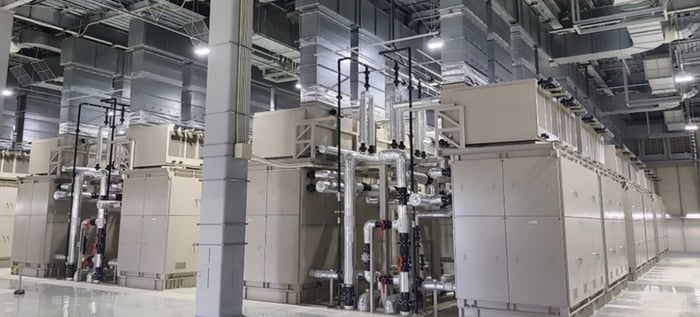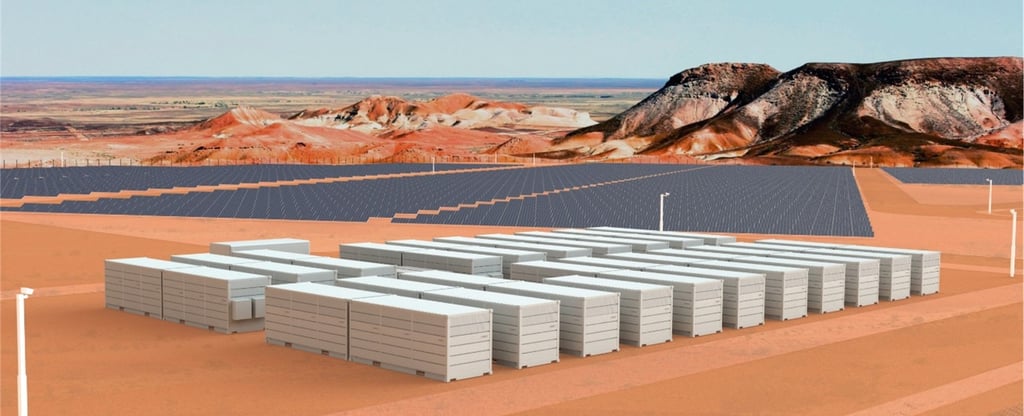Why vanadium redox flow batteries will be the future of grid-scale energy storage
The Australian Government has committed along with many other nations to global emissions reduction with a target of net zero by 2050. To get there, without a doubt, renewable energy sources will play a crucial role in Australia's road map.
Net zero and the role of energy storage
Adoption of existing technology will need to be utilised to maximise the use of renewable sources but also investment in new types of storage technology.
As Australian fossil fuel power stations are progressively decommissioned and the demand for renewable energy continues to grow, the need for solutions that can regulate the flow and frequency of electricity across the grid intensifies.
|
The Australian Energy Market Operator (AEMO) believes that over 30 gigawatts (GW) of large-scale renewable energy will be required to replace coal-fired sources by 2040, with 63 per cent of Australia’s coal-fired power plants set to retire by then. This problem gives rise to the need for effective and economical energy storage, with AEMO expecting battery storage installations to reach 5.6 GW by 2036-37, up from close to zero capacity today. |
The need for a solution to regulate variable renewable sources is reflected in the growing frequency of negative electricity prices in Australia.
Pricing in roughly 20 per cent of all 11:30am and 12pm trading periods in Queensland were negative in calendar year 2020, which is more than twice the number of incidences in 2019.
Electricity Pricing and Demand in Queensland. Source: AEMO
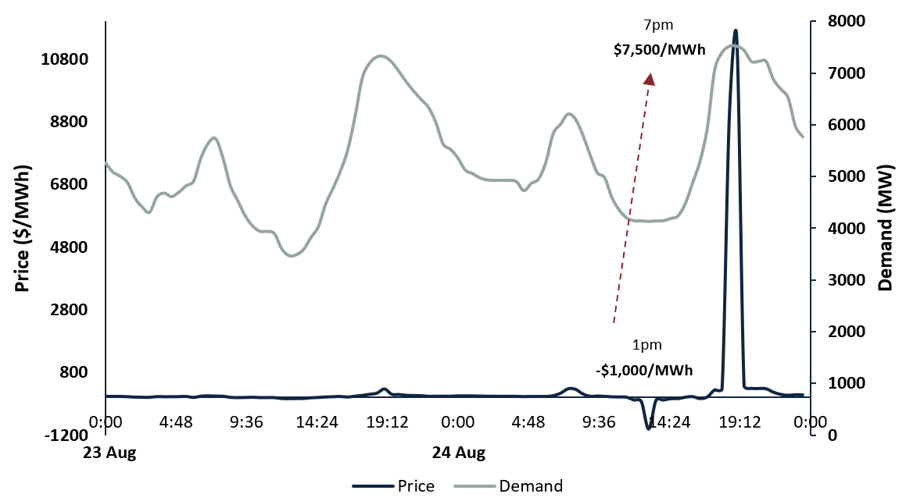
This is likely driven by the huge growth in rooftop solar PV installations in QLD, which has far outpaced new battery storage deployments. This is forcing coal-fired generators to bid below $0/MWh during the sunniest part of the day to stay online.
Two types of renewable energy sources used today to power in part the electricity grid networks are:
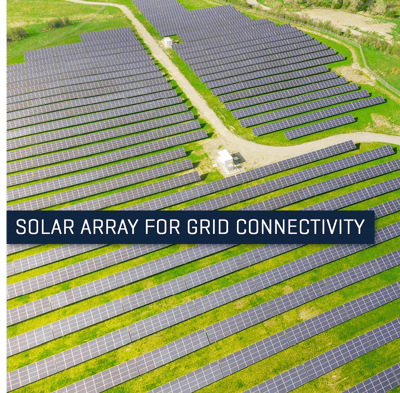

More recently large banks of lithium-ion batteries have been used as a stop gap to enhance storage capacity, but these types of battery systems come with risks and cost.
The potential danger of Lithium batteriesThe recent fire at the Victorian Big Battery project, one of the largest Tesla battery installations in the world with a capacity of 300 megawatts (MW), has drawn renewed attention to the risks of lithium-ion batteries in grid-scale energy storage applications. Li-ion batteries can catch fire in thermal runaway reactions when a battery is crushed or charged too rapidly. The reaction releases heat and a mixture of gases, which form a vapour cloud that can ignite and explode. The release of gases adds a level of complexity to dealing with these types of fires, which produce oxygen as they burn and can’t be extinguished with water. |
“There have been roughly 40 known fires at large-scale li-ion battery storage systems” Paul Christensen, a professor of electrochemistry at Newcastle University. |
|
Fire at the 300 MW Tesla battery in Moorabool, Victoria. Source: Fire Rescue Victoria
One of the battery modules caught fire and burned for almost four days before it was declared under control, after spreading onto a second 13 tonne lithium-ion (li-ion) battery.
One fire in Beijing killed two firefighters and took 235 firefighters to control, whilst another fire that took place in Arizona in 2019 threw a firefighter 20 metres, leaving him with a brain injury and broken ribs. |
Lithium-ion batteries have a high energy density and operating voltage and currently dominate the global energy storage market through their use in laptops, mobile phones and electric vehicles.
But whilst li-ion batteries will be essential to the decarbonisation of this planet, Christensen says that their penetration into society has far outstripped our actual knowledge of the risks and hazards associated with them.
So, what are the alternatives?
The vanadium redox flow battery (VRFB) was invented at University New South Wales (UNSW) in the late 1980s and has recently emerged as an excellent candidate for utility-scale energy storage.
Energy is stored in a liquid vanadium electrolyte and pumped through a membrane to generate electricity.
Vanadium ions are simply moved between oxidation states as batteries are charged and discharged, with no degradation over tens of thousands of charging cycles.
Sumitomo, for example, ran a field trial across three years from 2005 which found zero deterioration in battery performance over 200,000 cycles. Only the proton exchange membrane that the electrolyte passes over requires replacement every 10-20 years, giving rise to potential of long duration energy storage, when compared to li-ion batteries where the entire battery must be replaced
Vanadium redox flow battery. Source: Impress-energystorage.com
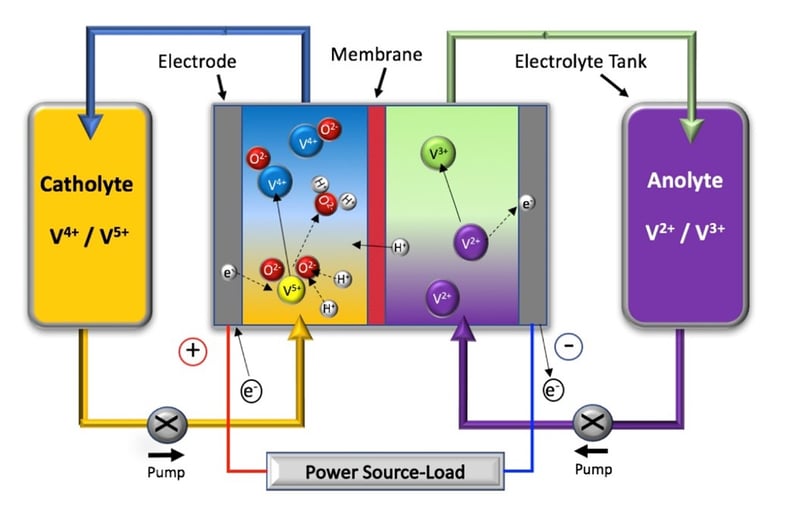
6 Benefits of vanadium redox flow batteries
Vanadium is the 13th most abundant metallic element on earth, and Australia has one of the world’s largest known vanadium deposits.
Benefits of VRFBs over li-ion batteries for renewable energy storage and grid applications include:
- Safety: a key distinction from lithium-ion batteries is that VRFBs are non-flammable with no risk of thermal runaway reactions. The chemistry involved also poses little health risk to humans.
- Environmental: VRFB manufacturing releases 78 per cent less CO2 emissions than the equivalent Li-ion battery, and 100 per cent of the vanadium electrolyte can be reused at the end of the project life. Because the electrolyte doesn’t deteriorate, it can be sold, or the vanadium extracted and sold for different applications.
- Lifespan: the type of chemical reaction that occurs in vanadium electrolyte gives the ability to discharge deeply (up to 100 per cent) and often with effectively zero degradation, accommodating a long battery lifespan of over 20 years. Solid-based batteries have a finite life as their performance degrades over time, accelerated by heat, operating conditions and the depth and frequency of discharges.
- Unlimited capacity: the use of a liquid electrolyte means VRFBs can be easily scaled by adding modules or increasing electrolyte tank size, resulting in a significantly lower cost per kWh for larger tank sizes with durations above 4 hours – perfect for utility-scale operations.
- Storage duration: longer storage durations than equivalent li-ion batteries (3-10 hours vs 2-4 hours in li-ion batteries) are suited to provide energy from renewable sources when the sun is not shining, and the wind is not blowing.
- Flexibility: rapid response times (within milliseconds) promote grid stability and reliability.
Li-ion batteries offer higher energy densities than VRFBs. However, when it comes to utility-scale storage, VRFBs have no fire risk and can be packed tighter than li-ion batteries, resulting in a comparable overall footprint.
Vanadium batteries can be more expensive than lithium-ion batteries to purchase and install but offer a lower cost per kWh over the battery’s life due to its long lifespan and unlimited capacity.
Industry analysts estimate li-ion prices to be around $450/kWh for commercial and industrial projects, with VRFBs currently meeting this price or less on an upfront basis according to Invinity Energy Systems Chief Commercial Officer, Matt Harper, “his company’s VRFBs are around 30 per cent cheaper than lithium in applications where the batteries are used daily, with “a clear path to 60 per cent below lithium within two to three years”.
Vanadium is notorious for its volatile pricing and accounts for 35 to 45 per cent of VRFB installation costs. According to industry analyst Terry Perles, “vanadium production continues to lag demand. 90 per cent of the world’s vanadium supply is currently used for steel, and roughly 1 per cent used in energy storage – a sector set to grow exponentially in the coming years. Market participants hope that momentum in VRFB deployments will encourage increased vanadium production, helping to stabilise prices.”
The installed cost of VRFBs is likely to fall further again with continued innovation in the technology and its supply chains, breaking down cost barriers and expanding the range of potential economical uses.
5 current uses for vanadium flow batteries
- Peak load management: balancing supply with demand in peak periods when local utility grids are unable to provide enough power, ultimately replacing natural gas peaker plants
- Grid services: frequency regulation and voltage stabilisation to ensure the quality and reliability of power for consumers, including the prevention of black outs.
- Facilitation of renewable energy use: store energy generated from wind and solar PV farms for use at any time of the day, supporting grid peak loads.
- Back-up power supply: provide an alternative energy supply with black-start capabilities in the event of an emergency power outage.
- Behind the meter services: support the integration of renewable energy sources in mini grids, which can operate “behind the meter” in places where power supply from the national transmission grid is irregular or does not reach. This will reduce the reliance on diesel-powered generators, which release harmful greenhouse gases and are subject to fluctuating oil prices.
Global vanadium flow battery deployments
Experts agree that largescale vanadium redox flow batteries will become increasingly cost-effective as demand grows and scale is achieved. There are several utility-scale VRFB batteries currently in development around the world.
|
15 MW/60 MWh VRFB by Sumitomo Electric Industries in Hokkaido, Japan. Source: Cenelest.org
The largest VRFB system is installed at Hokkaido Electric Power Co’s Minami-Hayakita power substation in Hokkaido, Japan with a capacity of 15 MW (60 MWh) (Figure 4). The system increased the power station’s capacity for wind and solar by roughly 40 MW. |
|
200 MW/800 MWh VRFB by Rongke Power Industries in Dalian Province, China. Source: Electrek.co
China’s Rongke Power Industries will take over the title of the largest VRFB in the world when its 200 MW (800 MWh) project in Dalian, China is completed (Figure 5). The system will provide power during demand periods, increase grid stability, and provide backup power in the event of an emergency. The plant is expected to shave roughly 8 per cent of Dalian’s peak load. |
|
Back home in Australia Yadlamalka Energy is developing a 2 MW (8 MWh) VRFB to support a 6 MW solar PV array near Hawker, South Australia (Figure 6). The project will be the first VRFB in the world to operate as a direct producer of electricity into the grid, with the objective to shift solar generation from the middle of the day to the evening peak period, every day. The project received $5.7 million of funding from the Australian Renewable Energy Agency and has completed engineering groundwork.
|
Key conclusions
- Lithium-ion batteries are ideal for mobile energy storage systems and applications and will continue to play an important role in slowing climate change. But in terms of stationary applications at grid scale, there is more than one solution.
- Vanadium redox flow batteries are a safe and effective choice for longer duration storage over 4 hours where energy is discharged every day, whilst li-ion batteries are more suited to store up to 4 hours of energy 50 times per year.
- VRFBs are cost-effective, recyclable and non-flammable, eliminating the risk of dangerous events like the Tesla lithium-ion battery fire in Victoria this year. As demand for renewable energy grows, demand for VRFBs will grow, lowering costs and facilitating a safe and effective path to net zero carbon emissions as we approach 2050.
Siecap Energy ServicesWe leverage our extensive experience by partnering closely with our energy clients and listening to their needs and goals. From resource development through to feasibility studies, governance, business improvement and project management, we produce realistic and sustainable solutions that improve bottom-line results through rapid implementation. |
- View our case study - Project Development Strategy for a listed Critical Minerals and energy developer

References:
-
Argus Media. (2021, March 22). VRFB applications to boost China's V demand: Correction. Retrieved from Argus Media: https://www.argusmedia.com/en/news/2196733-vrfb-applications-to-boost-chinas-v-demand-correction
Australian Energy Market Operator. (2021, August). Electricity Price and Demand . Retrieved from AEMO: https://aemo.com.au/aemo/apps/visualisations/elec-nem-priceanddemand.html
Cenelest. (2020, February 29). Industry visit of 15 MW /60 MWh VRFB. Retrieved from Cenelest: the German-Australian Alliance for Electrochemical Technologies for Storage of Renewable Energy: https://www.cenelest.org/2020/02/29/industry-visit-of-15-mw-60-mwh-vrfb/
Fitzgerald-Weaver, J. (2017, December 21). World’s largest battery: 200MW/800MWh vanadium flow battery – site work ongoing. Retrieved from Electrek: https://electrek.co/2017/12/21/worlds-largest-battery-200mw-800mwh-vanadium-flow-battery-rongke-power/
Impress Energy Storage. (n.d.). Redox Flow Battery. Retrieved from Impress Energy Storage: http://impress-energystorage.com/redox-flow-battery/
International Renewable Energy Association. (2019). Utility-Scale Batteries Innovation Landscape Brief. Retrieved from https://www.irena.org/-/media/Files/IRENA/Agency/Publication/2019/Sep/IRENA_Utility-scale-batteries_2019.pdf
Invinity Energy Systems. (2020, December 11). Creating Australia’s First Dispatchable Solar Power Plant. Retrieved from Invinity Energy Systems: https://invinity.com/australia-utility-scale-flow-battery/
Lazard. (2018). Lazard's Levelised Cost of Storage Analysis - Version 4.0.
Lourenssen, K., Williams, J., Ahmadpour, F., Clemmer, R., & Tasnim, S. (2019, August 31). Vanadium redox flow batteries: A comprehensive review. Journal of Energy Storage, 25. doi: https://doi.org/10.1016/j.est.2019.100844
Yang, Z. G. (2017, October 26). It's big and long-lived, and it won't catch fire: the vanadium redox flow battery. Retrieved from IEEE Spectrum: https://spectrum.ieee.org/its-big-and-longlived-and-it-wont-catch-fire-the-vanadium-redoxflow-battery
Contact us to enquire about how we can assist you with your energy projects:


